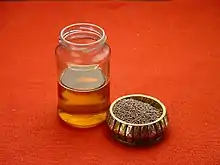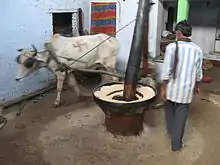Mustard oil
The term mustard oil is used for two different oils that are made from mustard seeds:
- A fatty vegetable oil resulting from pressing the seeds,
- An essential oil resulting from grinding the seeds, mixing them with water, and extracting the resulting volatile oil by distillation.

Pressed oil

This oil has a distinctive pungent taste, characteristic of all plants in the mustard family, Brassicaceae (for example, cabbage, cauliflower, turnip, radish, horseradish, or wasabi). It is often used for cooking in North India, Eastern India, Nepal and Bangladesh. In Bengal, Odisha, Assam, Meghalaya, Manipur, and Nepal, it is the traditionally preferred oil for cooking. The oil makes up about 30% of the mustard seeds. It can be produced from black mustard (Brassica nigra), brown Indian mustard (B. juncea), and white mustard (B. hirta).
The characteristic pungent flavour of mustard oil is due to allyl isothiocyanate. Mustard oil has about 60% monounsaturated fatty acids (42% erucic acid and 12% oleic acid); it has about 21% polyunsaturated fats (6% the omega-3 alpha-linolenic acid and 15% the omega-6 linoleic acid), and it has about 12% saturated fats.[1]
Potential toxicity
Mustard oil has high levels of erucic acid. Erucic acid has toxic effects on the heart at high doses.[2] Mustard oil is not allowed to be imported or sold in the U.S. for use in cooking, except for those products with exceptionally low erucic acid content.[3]
Nutritional information
According to the USDA,[4] 100 grams of mustard oil contains 884 calories of food energy, and is 100% fat. The fat composition is 11% saturated fat, 59% monounsaturated fat, and 21% polyunsaturated fat.[5]
Essential oil
The pungency of the condiment mustard results when ground mustard seeds are mixed with water, vinegar, or other liquid (or even when chewed). Under these conditions, a chemical reaction between the enzyme myrosinase and a glucosinolate known as sinigrin from the seeds of black mustard (Brassica nigra) or brown Indian mustard (Brassica juncea) produces allyl isothiocyanate. By distillation one can produce a very sharp-tasting essential oil, sometimes called volatile oil of mustard, containing more than 92% allyl isothiocyanate. The pungency of allyl isothiocyanate is due to the activation of the TRPA1 ion channel in sensory neurons. White mustard (Brassica hirta) does not yield allyl isothiocyanate, but a different and milder isothiocyanate.[6]
Allyl isothiocyanate serves the plant as a defense against herbivores. Since it is harmful to the plant itself, it is stored in the harmless form of a glucosinolate, separate from the enzyme myrosinase. Once the herbivore chews the plant, the noxious allyl isothiocyanate is produced. Allyl isothiocyanate is also responsible for the pungent taste of horseradish and wasabi. It can be produced synthetically, sometimes known as synthetic mustard oil.[7]
See also
References
- Entry for mustard oil in the USDA National Nutrient Database for Standard Reference, Release 22
- Food Standards Australia New Zealand (June 2003) Erucic acid in food Archived 3 December 2008 at the Wayback Machine : A Toxicological Review and Risk Assessment . Technical report series No. 21; Page 4 paragraph 1; ISBN 0-642-34526-0, ISSN 1448-3017
- FDA, 18 March 2011 FDA Import Alert 26-04
- "Welcome to the USDA Food Composition Database". nal.usda.gov. Retrieved 13 April 2018.
- Food Composition Databases Show Foods -- Oil, mustard (Retrieved 2017-12-11)
- "Mustard". A Guide to Medicinal and Aromatic Plants. Center for New Crops and Plant Products, Purdue University. Retrieved 3 January 2009.
- "Mustard Oil, Synthetic". JT Baker. Retrieved 3 March 2010.